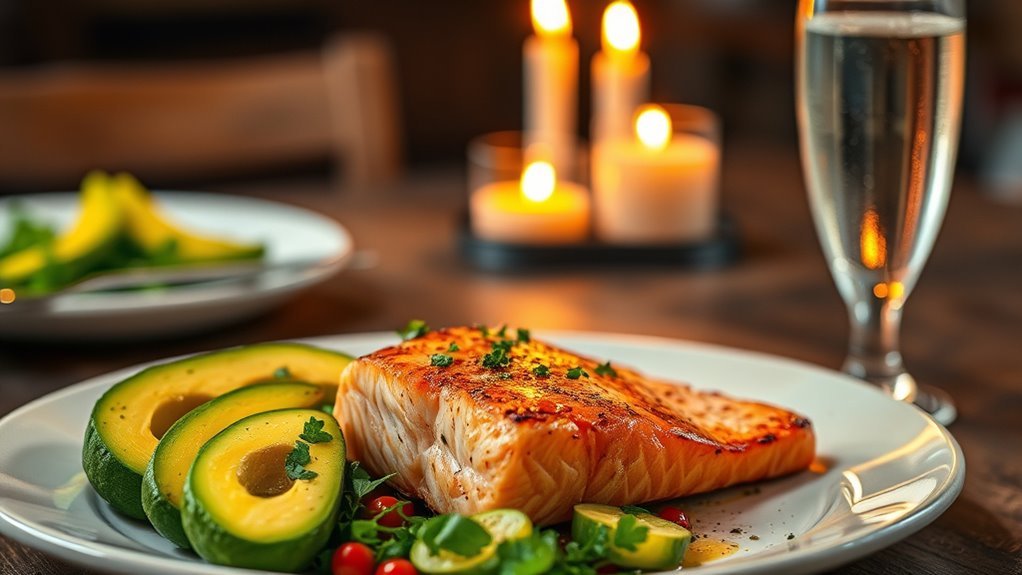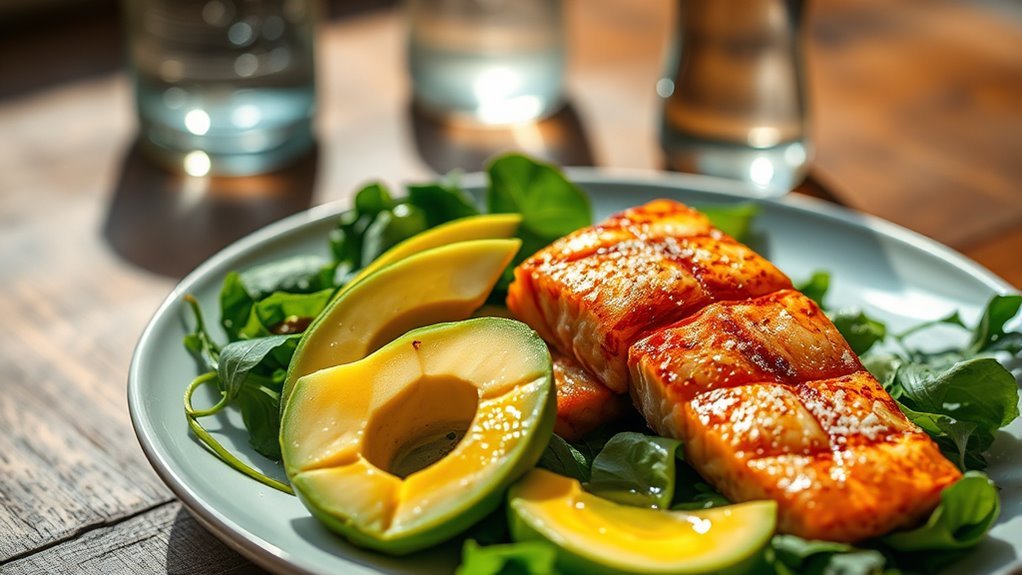You’ll start to feel less hungry on the ketogenic diet as your body adapts to using fat for fuel, usually within a few weeks. Initially, cravings may be strong, but as ketosis sets in, hunger often decreases due to hormonal changes that promote satiety. Balancing your macronutrients and staying hydrated can also help. If you adjust your meal timing and incorporate healthy fats and fiber, you’ll likely find it easier to manage hunger. There’s more to discover about sustaining your journey effectively.
Understanding the Ketogenic Diet and Hunger

When you start a ketogenic diet, understanding how it affects your hunger levels is crucial for your success. Many keto misconceptions suggest that you’ll constantly feel deprived or hungry. However, the reality is more nuanced. As your body adapts to burning fat for fuel, your hunger signals often change. Initially, you may experience cravings as your body shifts away from carbohydrates. But over time, many find that their appetite stabilizes. This occurs because healthy fats and proteins can promote satiety, helping you manage hunger more effectively. Tracking macros becomes essential as you listen to your body’s hunger signals. Embracing this journey allows you to find freedom from constant cravings, ultimately leading to a more balanced relationship with food while on the ketogenic diet.
The Role of Ketosis in Appetite Regulation

When you’re in ketosis, your body undergoes significant changes that can affect hunger hormones. This state not only influences your appetite but also plays a key role in the fat adaptation process, helping your body become more efficient at burning fat for fuel. Understanding these mechanisms can clarify why you may experience reduced hunger over time on a ketogenic diet. Additionally, improved insulin sensitivity can further contribute to appetite regulation, making it easier to manage hunger levels.
Ketosis and Hunger Hormones
Although shifting to a ketogenic diet can initially stir up feelings of hunger, the process of ketosis plays a significant role in regulating appetite. During ketosis, hormonal balance shifts, leading to appetite suppression. Ketones influence metabolic responses and enhance leptin sensitivity, which helps your body recognize satiety signals more effectively. As ghrelin levels—the hormone associated with hunger—decrease, your hunger cues become less pronounced. This neuropeptide modulation supports energy homeostasis, allowing you to feel satisfied with fewer calories. Over time, the body adapts to a new energy source, improving hunger regulation. Additionally, hidden carbs can disrupt this process, making it crucial to monitor your food intake as you transition into ketosis. Embracing this phase can empower you to navigate your dietary journey with greater confidence and freedom, ultimately leading to a more sustainable lifestyle.
Fat Adaptation Process
As your body begins to adjust to ketosis, the fat adaptation process plays a pivotal role in how you experience hunger. During this phase, your metabolic efficiency improves, allowing your body to utilize fat as its primary energy source. This shift often leads to more stable energy levels and diminished hunger signals, as your body learns to rely on stored fat rather than glucose. Nutrient absorption also plays a role; optimizing your diet for healthy fats can enhance this process. As you adapt, you may notice changes in your body composition, reducing cravings and promoting a sense of freedom from constant hunger. Embracing fat adaptation ultimately supports a sustainable and fulfilling keto lifestyle. Additionally, understanding the macro distribution of fats, proteins, and carbohydrates is crucial for effective hunger management on keto.
Factors That Influence Hunger on Keto

Understanding the factors that influence hunger on a ketogenic diet is essential for successfully managing your appetite and achieving your health goals. Hunger triggers can stem from various psychological factors, including emotional eating and stress influences. Your meal composition plays a significant role; meals rich in nutrient density can keep you satisfied longer. Additionally, hormonal fluctuations can impact your hunger levels, often leading to cravings. The food environment around you, including social dynamics, can also affect your eating habits and hunger perception. Finally, individual metabolism variations mean that what works for one person may not for another. By recognizing these factors, you can better navigate your hunger and maintain your keto lifestyle with greater freedom and success. Moreover, staying aware of your body’s reaction to alcohol consumption can help you avoid unnecessary cravings and maintain your appetite control.
The Importance of Macronutrient Ratios
Understanding macronutrient ratios is essential for your success on a keto diet. Ideal fat intake, protein requirements, and carb limits all play significant roles in managing hunger and promoting satiety. By balancing these elements, you can better control your appetite and enhance your overall keto experience. Incorporating healthy fats into your meals can further help in achieving that feeling of fullness and satisfaction.
Ideal Fat Intake
To achieve optimal results on a ketogenic diet, it’s important to pay attention to your fat intake, as the right macronutrient ratios can greatly influence your hunger levels and overall success. Focus on ideal fat sources like avocados, nuts, and olive oil, while considering fat quality to guarantee you’re fueling your body properly. Ideal fat ratios typically involve a higher percentage of fats, but fat intake variations may suit different individuals based on lifestyle and activity. Tracking fat intake is vital, as it helps in adjusting fat levels to meet personalized fat needs. Don’t fall for fat intake misconceptions; understanding the balance between quantity and quality can help you feel satisfied and thrive on your keto journey. Additionally, incorporating high-quality protein sources into your meals can further enhance satiety and support muscle maintenance during your keto transition.
Protein Requirements Explained
While many people focus heavily on fat intake in a ketogenic diet, protein requirements play an essential role in maintaining balance and achieving satiety. Understanding your protein needs can help prevent hunger and support muscle maintenance.
Here’s a quick overview of protein sources and timing:
| Protein Source | Protein Content (per 100g) |
|---|---|
| Chicken Breast | 31g |
| Salmon | 25g |
| Eggs | 13g |
| Tofu | 8g |
| Greek Yogurt | 10g |
Incorporating a variety of protein sources throughout the day is key. Aim for ideal protein timing—distributing your intake evenly can help sustain energy and curb hunger. Remember, it’s all about finding the right balance for your body! Additionally, focusing on whole, nutrient-dense foods can further enhance satiety and support your ketogenic journey.
Carb Limits and Effects
Establishing appropriate carb limits is essential for anyone following a ketogenic diet, as it directly influences your body’s ability to enter and maintain ketosis. Keeping your carb intake low helps minimize carb cravings, making it easier to adhere to the diet. When you first start keto, you might experience the “keto flu,” a temporary phase where your body adjusts to burning fat for fuel instead of carbs. This can involve fatigue and irritability, but it usually passes within a few days. Maintaining the right macronutrient ratios—typically around 5-10% of your daily intake from carbs—ensures you’re getting enough fat and protein to feel satisfied. Additionally, daily carb limits generally range from 20 to 50 grams to support staying in ketosis. Remember, finding your ideal carb limit is key to enjoying the benefits of keto without feeling deprived.
Staying Hydrated: How Water Affects Hunger
Have you ever noticed how a glass of water can sometimes quell that nagging hunger? Staying hydrated is key to achieving appetite control on a ketogenic diet. Often, our bodies confuse thirst signals for hunger, leading to unnecessary snacking. Here are some hydration strategies to contemplate:
Staying hydrated can curb hunger and prevent unnecessary snacking on a ketogenic diet.
- Guarantee adequate water consumption throughout the day.
- Monitor your electrolyte balance to prevent fluid retention.
- Pay attention to your body’s thirst signals. Additionally, consider that adequate water intake can support balance during keto adaptation and help manage hunger effectively.
Meal Timing and Frequency on a Ketogenic Diet
When should you eat to best manage hunger on a ketogenic diet? The answer lies in understanding meal timing and how it relates to your hunger signals. Many find success with intermittent fasting, allowing longer breaks between meals. This approach can help your body adapt to using fat for fuel, potentially reducing hunger pangs over time. You might choose to eat two to three meals a day, focusing on nutrient-dense foods that satisfy you. Listening to your body is key—pay attention to when you feel genuinely hungry instead of eating out of habit. Ultimately, finding a routine that feels liberating and aligns with your lifestyle will make your keto journey more enjoyable and sustainable.
Tips for Managing Cravings and Hunger
While cravings can be challenging on a ketogenic diet, implementing a few effective strategies can help you manage them more successfully.
- Prioritize mindful eating to recognize hunger cues and differentiate between true hunger and emotional eating.
- Prepare low carb snacks in advance to resist stress eating and guarantee healthy options are always available.
- Utilize food journaling to track your cravings and identify potential hunger triggers, allowing for better craving management.
The Impact of Fiber and Fats on Satiety
Understanding how fiber and fats influence satiety is essential for anyone on a ketogenic diet. Fiber sources, like avocados and leafy greens, can help regulate hunger signals by slowing digestion and promoting a feeling of fullness. Incorporating these foods into your meals can provide significant satiety boosts. On the other hand, the types of fats you choose also play an important role. Healthy fats, such as olive oil and nuts, can enhance your overall satisfaction with meals, prolonging that sense of fullness. Balancing fiber and fats in your diet not only helps curb hunger but also supports sustained energy levels throughout the day, allowing you to enjoy the freedom that a keto lifestyle can offer.
Long-Term Adjustments: What to Expect Over Time
As you continue on your ketogenic journey, it’s common to experience shifts in hunger levels and cravings over time. These changes are part of your body’s long-term adaptation to ketosis and can lead to improved control over your hunger patterns.
- You might notice reduced cravings as your body becomes more efficient at burning fat for fuel.
- Hunger may become less frequent and more manageable as your body adjusts.
- Emotional eating triggers may diminish, allowing for greater freedom in food choices.
It’s essential to listen to your body and adjust your intake based on genuine hunger signals. Embracing this journey means recognizing that your relationship with food will evolve, leading to a more balanced, fulfilling lifestyle.
Frequently Asked Questions
Can I Eat Snacks While on the Ketogenic Diet?
Yes, you can definitely eat snacks while on the ketogenic diet! Opt for keto-friendly snacks like nuts, cheese, or avocado to help curb hunger cravings without breaking your carb limit. It’s important to listen to your body and choose snacks that support your energy levels. Just remember, moderation is key. Keep your snacks satisfying and nutritious, so you can enjoy the freedom of snacking without feeling guilty or derailing your progress!
Will I Feel Hungry During My Keto Transition Phase?
Yes, you might experience keto hunger during your changeover phase. This is common and part of the changeover challenges many face when shifting to a low-carb diet. Your body’s adjusting to using fat for fuel instead of carbs, which can lead to temporary hunger. Staying hydrated and ensuring adequate fat intake can help curb these feelings. Remember, this phase won’t last forever, and listening to your body is key to finding balance.
How Do I Know if I’m in Ketosis?
You’ll know you’re in ketosis by observing several signs. Common ketosis signs include increased energy, reduced hunger cues, and a distinct metallic taste in your mouth. You might also notice a change in your breath, often described as fruity or sweet. Additionally, monitoring your ketone levels with urine strips or a blood meter can provide clarity. Remember, every body is different, so pay attention to how you feel throughout this journey.
Are There Specific Foods That Help Reduce Hunger?
You might think munching on endless salads will keep you full, but it’s actually fiber-rich foods and healthy fats that do the trick. Foods like avocados, nuts, and seeds provide satiety and help stabilize your blood sugar, making them perfect for your journey. Combining these with fibrous veggies can keep hunger at bay. Embrace these choices, and you’ll find yourself enjoying the freedom of feeling satisfied longer without constant cravings.
What Are the Signs That My Body Is Adjusting to Keto?
You’ll notice several keto adaptation signs as your body adjusts. These include reduced hunger, increased energy levels, and improved mental clarity. You might experience a decrease in cravings as your hunger regulation stabilizes, signaling that your body is burning fat for fuel. Additionally, some people report fewer mood swings and better sleep quality. These changes can take time, but they’re positive indicators of your body adapting to a ketogenic lifestyle.


